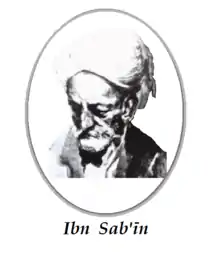Ibn Sab'in
Ibn Sab'īn (Arabic: محمدبن عبدالحق بن سبعين ʿAbd al-Ḥaqq b. Sabʿīn al-Mursī) was an Arab[1][2] Sufi philosopher, the last philosopher of the Andalus in the west land of Islamic world. He was born in 1217 in Spain and lived in Ceuta. It has been suggested that he was a Neoplatonic philosopher, a Peripatetic philosopher, a Pythagorean philosopher, a Hermeticist, a Kabbalist, an alchemist, a heterodox Sufi, a crypto-Shīʿī, a plagiarizer, a pantheist, and an arrogant seeker of fame, though none of these adequately characterise Ibn Sab'in.[3]
ʿAbd al-Ḥaqq b. Sabʿīn al-Mursī محمدبن عبدالحق بن سبعين | |
|---|---|
 | |
| Born | 1216/1217 CE |
| Died | March 21, 1271 CE (9 Shawwal 669 AH) |
| Notable work | Sicilian Questions |
| School | Founder of the Sab'iniyya |
Main interests | Sufism and philosophy |
Ibn Sabʿīn is most famously remembered for his replies to questions sent to him by Frederick II, Holy Roman Emperor.[4] He was recognized by Michele Amari[5] as the author, among others, of the responses to the famous Sicilian Questions. He was also the author of the Budd al-Arif, amongst other works. He was also known for his knowledge of the "hidden sciences" and was well versed in knowledge of Islam and of other religions.[6] From his time and continuing through to today, Ibn Sabʿīn has been criticized for his views, though often by detractors who did so without an in-depth knowledge of his works, as many of the accusations against Ibn Sabʿīn are invalidated by Ibn Sabʿīn’s own writings, and suggest that some of our author’s critics were not even familiar with his works.
In approximately 668/1270 Ibn Sabʿīn died in Mecca, under suspicious circumstances.[7] There are two descriptions of his death, one that states that he was poisoned and another that reports that he committed suicide.[3] However there is evidence indicating that the story of Ibn Sabʿīn’s suicide was fabricated. Casewit states that “his alleged suicide seems untenable firstly because it was related by one of Ibn Sabʿīn’s foes, and secondly because suicide is wholly contrary to both Islamic law and Ibn Sabʿīn’s philosophical beliefs.”[8] Despite the mutually exclusive versions, it is the more controversial suicide adopted by Massignon and Corbin that is repeatedly stated, and even fictionalised by Bensalem Himmich in A Muslim Suicide.[9]
Notes
- Leaman, Oliver (2013-03-07). History of Islamic Philosophy. Routledge. ISBN 9781136780448.
- Leaman, Oliver (2015-07-16). The Biographical Encyclopedia of Islamic Philosophy. Bloomsbury Publishing. ISBN 9781472569455.
- Cook, Benjamin G. (2012-07-01). "Ibn Sabʿīn and Islamic Orthodoxy: A Reassessment". Journal of Islamic Philosophy. 8: 94–109. doi:10.5840/islamicphil201288.
- Luisa Arvide, Las Cuestiones Sicilianas de Ibn Sabin, GEU, Granada 2009 (in Arabic and Spanish).
- Michele Amari, Questions philosophiques adressées aux savants musulmans par l'Empereur Frédéric IIe, in Journal asiatique, Ve serie, 1, Paris, 1853, pp. 240-274.http://gallica.bnf.fr/ark:/12148/bpt6k931611/f240.pagination.r=Michele+Amari.langEN.
- S. H. Nasr (2006), Islamic Philosophy from Its Origin to the Present: Philosophy in the Land of Prophecy, State University of New York Press, pp. 156-157.
- Akasoy, Anna Ayşe (2008-06-30). "Ibn Sab'īn's Sicilian Questions: the Text, its Sources, and their Historical Context". Al-Qanṭara. 29 (1): 115–146. doi:10.3989/alqantara.2008.v29.i1.51. ISSN 1988-2955.
- Casewit, Yousef (2008). "The Objective of Metaphysics in Ibn Sabʿīn's Answers to the Sicilian Questions" (PDF). Iqbal Review. 49: 102.
- "Muslim Suicide, A – Syracuse University Press". Retrieved 2023-09-12.